Sleeping on the bedroom floor, copying Goggins and camaraderie - how Emily Moore ran the Marathon des Sables
Why 'Tent 80' proved the key to MDS success for triathlete and ultra runner, Emily

Sleeping on the floor for three months, running in a heat chamber and walking miles across inhospitable terrain.
You’d be forgiven for thinking Emily Moore had been sucked into the middle of a fantasy film quest. Possibly involving a hobbit and a dwarf.
Or maybe Star Wars - but then again triathlete and ultra runner Emily has never seen the George Lucas sci-fi classic.
She has, however, ran through the desert it was filmed in.
In April, Emily took on - and defeated - the six-day, 250km (155-mile) Marathon des Sables, an event which runs through the Sahara Desert in Morocco and has been dubbed ‘the toughest footrace in the world’.
Her months spent sleeping on the bedroom floor and heat chamber runs at Wolverhampton University were preparation for the adventure of a lifetime, while the days spent walking up and down mountains came during a preparatory multi-day ultra across Nepal.

That race - the Capital to Country Multi-Day Ultra Marathon - took place over five days and 123-miles last year, with Emily power-walking the entire distance.
“I knew it was going be hot at MDS,” she told the Running Tales Podcast. "I thought, ‘I'm never going to be able to run this’ so I wanted to mentally get ready for the walking side of things.
“I think sometimes as ultra runners or marathon runners, we think if we walk we’ve failed, and I didn't want that to be in my head. I just wanted to think that walking didn't matter. If I was crawling on my hands and knees, I was still moving forward.”
Part two of preparing for the heat came with a trip to Wolverhampton and the university’s heat chamber: “They were increasing the temperature while I was running. It was about learning how my body reacted to it.
“They were analysing what it felt when my body was at a certain core temperature. We talked about muscle memory and about knowing what that kind of heat is like, as I had never run in it before.”
If running in what was effectively a sauna seems extreme, Emily’s next training tactic came straight out of the David Goggins playbook.
One of former US Navy SEAL, ultra runner and author Goggins’ famed runs is the 4x4x48 Challenge. It involves running four miles at the beginning of every four hour period on repeat for 48 hours.
The aim of the run was not only to boost Emily’s fitness levels, but to get used to running on a lack of sleep.
She said: “It rained overnight, but it was great. I thought that it sounded like a really good idea to know what it was like to run totally exhausted and to have to keep getting up when you're tired.
“I also did laps of my local reservoir. That was really boring, because I didn't take any music or anything.
“I had this front pack which I’d borrowed, and the elastic on the top that holds the bottle down was broken. This bottle was just hitting me in the face on repeat.
“I did 35 miles that day, and then 35 miles the next day - all with this bottle smacking me in the face.”
‘Lying on your sleeping bag talking about crisps’:

If training hard is the first step to Marathon des Sables success, the next is finding a good team of tent mates.
Veteran MDS campaigners tell stories of wondering around camp trying to find a spare spot in a tent, but these days people can pre-book a space and check out the runners they are going to be sharing the sand with.
Emily quickly found a unique way to take advantage of the new system.
“This is really bad, I’m going to let out all the secrets,” she said. “I wanted to go in a tent with mainly men, because the first person back each day has to clear the stones away from underneath the rug that you're going to sleep on.
“I figured if I went with it in a tent with men, they would definitely get back before me - then they would have to sort out the stones. And I could drift in and everything would be ok.”
Also on Running Tales:

“A lot of the reactions to women who have been harassed or killed outside is that they shouldn’t go out in the dark,” says Dr Ashley Morgan.
“That it is the dark that is the problem. And I think that obfuscates the issue, which is the problem is men who want to attack women…”
Click the headline above or here to read this story in full.
She found a couple of tents which had six male competitors in - four was deemed too much of a risk, speed wise, narrowing her options down to Tent 79 or 80.
“It was a toss up, and I went for Tent 80 - and I'm really glad I did because the people were brilliant.
“I loved them all. I’d done some research online and we’d all found each other on Facebook and things like that. The only person we couldn't find was Archie. We didn't know who he was.
“We got to the desert and we were like, ‘has anybody seen Archie?’ And then this young, absolutely taller than tall lad turns out to be Archie and he's got the edge of the tent where there's no room!”

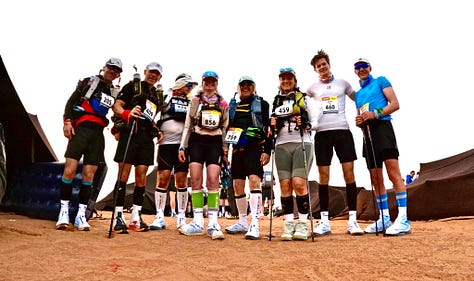
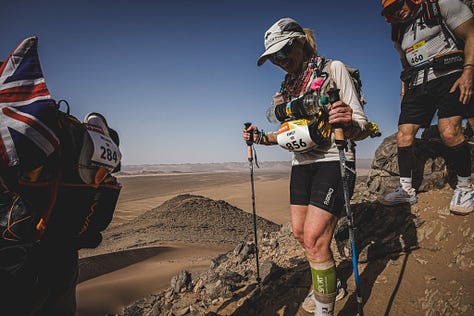


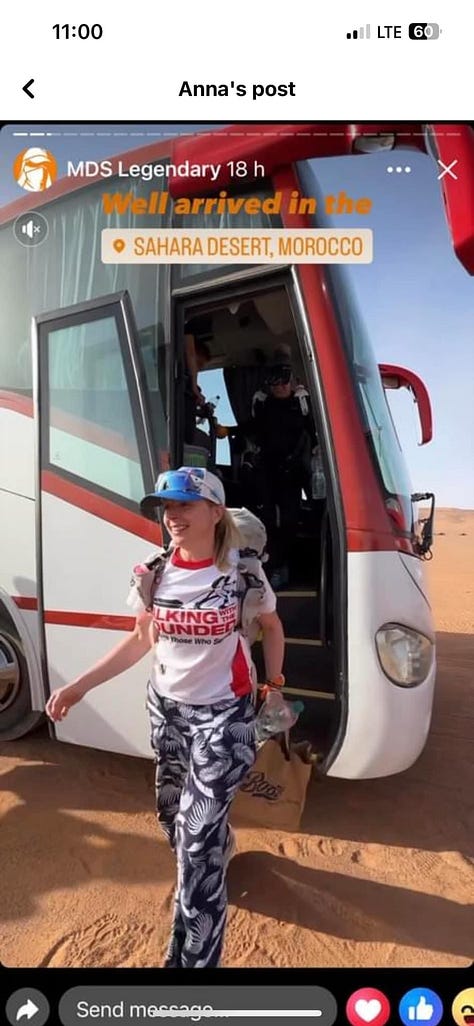
The members of Tent 80 bonded “instantly,” something Emily said isn’t always standard practice but was boosted by an early icebreaker.
“We instantly got on, I'd say within about an hour, mainly because I slipped when getting changed. I have no airs or graces about this kind of thing. I was going to be sharing a tent with these guys for seven, eight days, so I wasn't going to be walking to get changed in the little cubicles that are a trek away.
“I just decided I was going do it. I was on an inflatable mattress and stumbled, and poor Alex saw everything that I own! We were all fully on board then!
“The running is one thing, but actually the stuff back at Tent 10, that's what really makes MDS special. It's that time away from everything else, from social media, from phones, from work, absolutely everything.
“You're just there running, or walking, eating, lying on your sleeping bag talking about crisps.”
Whooping like a child and beating blisters:

But what is running the Marathon des Sables actually like? Emily immediately reached for two words: ‘hot’ and ‘beautiful’.
“It's so hot,” she said. “Some days aren't as sandy as what you imagined they would be. It's a lot more rocky underfoot, and we went over some jebels (an Arabic word for hill or mountain) that were quite extreme.
“One of the best bits was going up over the top of this jebel, and then there was a rope on the other side and you lowered yourself down for a little bit, and then the rope ran out. And there was nothing else to do, but just to run, full pelt with all your kit on your back and a bottle strapped to your front, down this sand.
“That was one of the best moments for me. I was whooping like a child. But it is tough. Day four was one of the toughest days for me. There were constant waves of sand - it was relentless, and the heat was just exhausting.
“But it's spectacular. It is spectacular. And obviously we got to see the night sky on the long stage which was unbelievable.
“There's just the sun and the height of everything, and a really odd eerie, muffled sound - like when it snows in the UK. The sound is very strange out there. But beautiful. Really beautiful.”



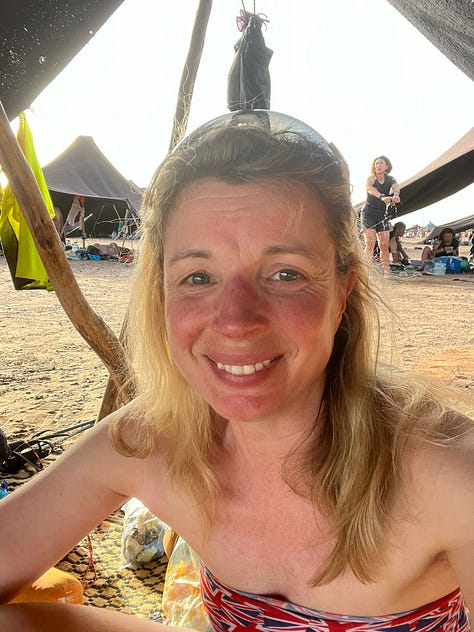

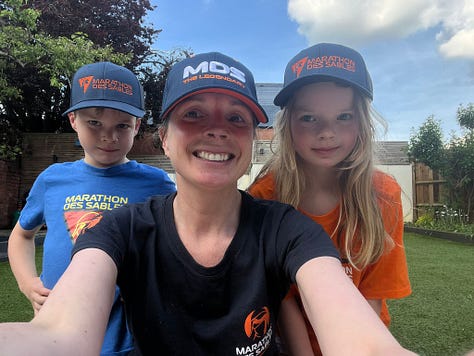
Despite the heat and sand, Emily managed to avoid the worst of those ultra runners’ nightmares that come in the form of dehydration, blisters and chafing.
Some of her tent mates were not so lucky, with one - Alex - having to have his toenails drilled by medics after day one so they could release blisters from under them.
“I've never told them this, but I only had two tiny, tiny blisters on my little toes,” Emily said.
Her secret was the unusual tactic of applying a lotion usually used on dog’s paw pads and horses hooves. Despite being “the most disgusting smell I've ever smelled,” she sprayed her feet with it religiously.
“I also taped my feet really well. I learned how to do that. I think I've got about 12 different types of tape upstairs in my bathroom that I practiced with.”
While also escaping the threat of chafing, Emily did fall foul to sores on her back - collected due to her rucksack rubbing: “I don’t know if it was the result of the heat, but they were really bad.
“Fortunately, they have fantastic medical teams when you do MDS. There were fantastic British nurses and doctors out there looking after us as well, and they took care of that for me.”
This article involved hours of planning, preparation, interviews and writing. It takes less than a minute to leave a tip to make it all worthwhile. Thank you 🙏
In terms of getting water on board, Emily told Running Tales that rules at MDS had changed in 2024 to allow runners to put as much water in bottles as they wanted.
Although people were still limited by how much they could physically carry, this helped reduce the potential for dehydration.
“In previous years, they’ve given people three one-and-a-half litre water bottles at each checkpoint,” Emily said. “I physically couldn't have carried that - and I didn't this time.
“I had two bottles on my front, and then I also had another with beef Oxo cube stock in it, which gives you the salt you need. Then, I was able to fill my bottles up at every checkpoint.”
The amount she carried in her rucksack was another detail Emily carefully planned.
At just five foot four and weighing 52 kilos (eight stone), she “was aware that whatever I carried, it would be a high percentage of my bodyweight.
“I got to the point where I was choosing between different head torches because one was a couple of grams lighter.
“I did take flip flops though. I knew that when we got back to camp I'd want to put my feet into something comfortable.”
‘My tent mates are stuck with me for life’:

From following Goggins’ training plan to literally weighing up your options when selecting kit, there’s a lot that goes into taking on the Marathon des Sables.
But when asked what one thing anyone needs to take on the desert race, Emily didn’t hesitate.
“I'm going to say you run MDS on camaraderie,” she told Running Tales.
“There's no other way to do it. It's about mental strength and it doesn't matter how much training you put in - you’re never fully prepared.
“So much can go wrong in the Sahara, whether it be the heat affecting your stomach, your feet, or back sores.
“But you do it with your mates. You make mates there. I didn't know my tent mates at all before I went, but they’re stuck with me for life.”
If you enjoy this article, check out some of the inspirational running stories on this newsletter and subscribe to make sure you never miss another article.
The do's and don'ts of how to treat disabled runners
From grabbing wheelchair users to push them along to trying to barge through tethers being used by guide runners, there are plenty of lessons some runners could learn about how to treat disabled athletes. That’s not to say there aren’t plenty of positive experiences to talk about as well, with some run directors embracing diversity within their events.
How 'running like a cheetah' has boosted Chicago school kids' behaviour and confidence
“The Cheetah program has given my student a confidence in the classroom that he did not have prior to the program. “It offers him an intimate environment - a small group to allow his needs to be met. On the day he attends the Cheetah program, I notice a more positive perspective on learning.”
From marathons to best selling books - how running changed Hannah Phillips' life
Running Tales: After all is said and run is a reader-supported publication. To receive new posts and support my work, consider becoming a free or paid subscriber.






